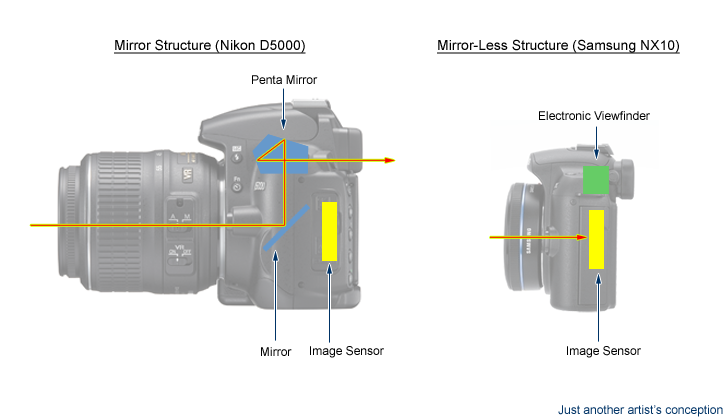|
Page 2 of 7
General

Electronic Viewfinder Interchangeable Lens
The idea of Electronic Viewfinder Interchangeable Lens cameras(EVIL) is pretty simple - the electronic viewfinder reduces the conventional combination of a moving mirror and a focal plane shutter to the latter. And this design makes it possible to build smaller and smaller body's with interchangeable lenses.

Compared to conventional DSLRs there are both advantages and disadvantages with this approach. The electronic viewfinder appears brighter in low light situation due to a "low-light amplifier" so it gives more control here albeit at cost of a noisy viewfinder image. Furthermore, it offers a scene coverage of almost 100% and it is fully customizable for examples with superimposable guiding lines and a live histogram. An electronic viewfinder can also be useful in bright weather conditions because they can also serve as playback screen so you don't run into the contrast/brightness problems of an external screen.
However, this kind of viewfinders have a weakness in sports photography because the refresh rate tends to be rather slow. All electronic components draw battery power and an electronic viewfinder is - like a live view display - a high power consumer here. As of today the display resolution is also rather limited and the Samsung NX10 is, unfortunately, no exception to the rule here.
AMOLED Display (external)
The Samsung NX10 features a 3.0" Active-Matrix Organic Light-Emitting Diode (AMOLED) screen. It's really a great display with a great viewing angle as well as high contrast (10000:1) and brightness. This display delivers comparatively sharp and colourful images - even in sunny conditions - at a very good response time.
AF
The Samsung NX10 relies on a contrast detection AF system just like the other micro-system cameras. This kind of AF is based on a contrast analysis based on the camera's main sensor. This isn't quite as efficient as the phase-detection system found in a conventional DSLR but it is actually pretty fast. The Samsung is about on par with the Panasonic and Sony EVILs. The AF tracking performance, and that's a weak spot of all EVILs, remains unimpressive. You can choose a specific AF spot or leave it to the camera. Face detection is also available. In low light there's an AF support light.
Metering
The camera has the usual set of metering modes - spot, center weighted average and 247 multi-segment metering. The data is obtained directly from the main sensor so this is very reliable (more so than on DSLRs). The white balance system is about class standard. It works fine in normal situations but artificial light can fool it at times. There is, of course, an option for manual WB.
Manual focusing
Unlike DSLR systems the Samsung provides manual focusing "by wire". If you turn the focus ring on the lens this will actually drive the lens AF motor - the ring is not coupled to the mechanical focus gears of the lens. A really nice feature is the automatic region magnification which is triggered automatically once you turn the focus ring. This can be a very useful characteristic especially for macro photography or if you'd like to use an adapter solution with a manual lens. However, Samsung missed the mark here because 2 x magnification is just too coarse for accurate manual focusing.
Body
We'll not describe the different buttons and control rings of the camera - most readers are probably very familiar with the basic functions of a system camera anyway.

(1) Depth preview button, (2) AF-assist light/timer lamp, (3) Microphone, (4) Lens removal button

(5) Eye sensor, (6) MENU button, (7) Diopter adjustment dial, (8) Hot-shoe, (9) EV button, (10) AEL button, (11) DISP button, (12) Function(Fn) button, (13) Direction key, (14) Delete/Picture wizard button, (15) Playback button, (16) Status lamp

(17) Flash button, (18) Power switch, (19) Shutter button, (20) Dial, (21) Green button, (22) Drive mode button, (23) Mode dial
|